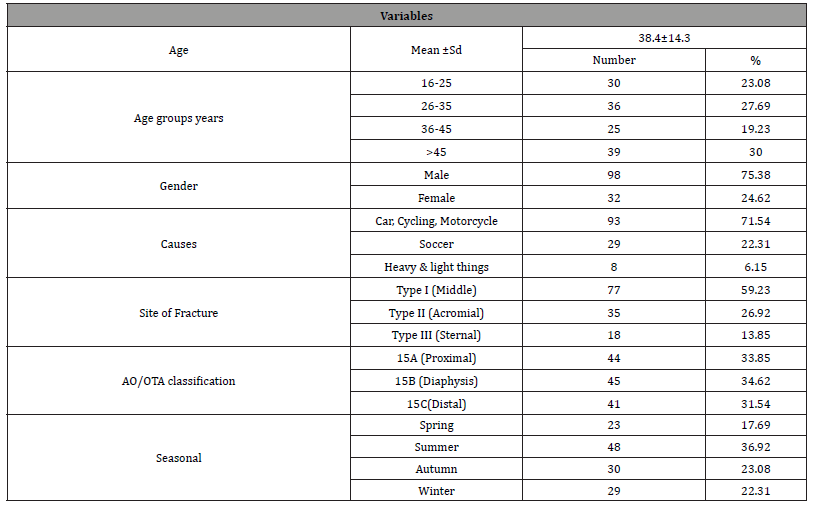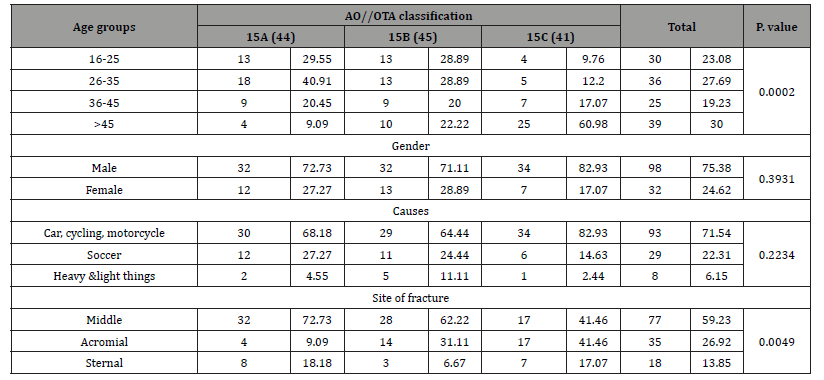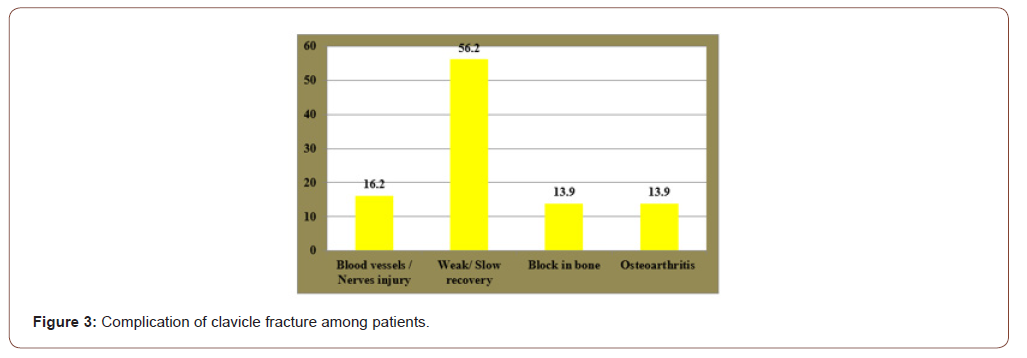Authored by Saman Mohammad Abdul Razaq*,
Abstract
In recent years, collarbone fractures have been a common occurrence among adults and the elderly. This study aimed to assess the characteristics of clavicle fracture among patients and, also to identify the complication of clavicle fracture; whether it had an impact on treatment ways during the period of study. A cross-sectional study was conducted in eight general hospitals in Baghdad during the period from August 2020 up to May 2021 in order to determine the epidemiology and characteristics of people with collarbone fractures. The sample size was 130 samples. The information was collected directly from the patient or the patient’s relative. STATA 20 software package was used to calculate the figures and perform all the tests at the P value <0.05 was considered as statistically significant. The mean age and SD were 38.4±14.3; highest frequency 30% of clavicle fracture occurred among them in the age groups more than 45 years old and 27.69% in the age 26 to 35 years old. The majority of them were male 75.38% and 24.62% were female. Most of them 71.54% were exposed to clavicular fracture as an accident by car, cycling and motorcycle. 59.23% of them suffering from the middle fracture. There is highly significant association has been found between the age groups and AO/OTA classification at the p. value =0.0002 and, significant relationship has been found between the sites of fracture with AO/OTA classification at the p. value less than 0.05. Weak /slow recoveries were the main complication of clavicle fracture among studied samples. We need to encourage the clinicians to attend the scientific conferences and educational seminars.
Keywords: Fracture; Clavicle; Accident; Complication; Assess; Baghdad; Accident
Introduction
Clavicle fractures occur commonly, often because of indirect or direct trauma to the shoulder region [1,2]. The incidence of clavicle fractures in adolescent and adult population is suggested to be between 29 and 64 per 100.000 persons [3]. As usual, in many traumas, its prevalence is highest among the young population even if also shows a bimodal age distribution with a rate in females that overtake males after the sixth decade of life because of osteoporosis and differences in life expectancy [4,5]. The mean age has been reported to be 29.3 years, and the incidence appears to decrease significantly after the second decade of life [6]. Males are affected approximately twice as often as females (67.9% vs 32.1%) [6]; these injuries may also have a seasonal correlation, with one epidemiologic analysis noting an increase during the summer [6,7]. In adults, more than two-thirds of these injuries occur at the diaphysis of the clavicle, and these injuries are more likely to be displaced as compared with medial and lateral third fractures [8,9]. Lateral-third fractures are less common, accounting for approximately 25% of all clavicle fractures, and are less likely to be displaced than those occurring in the midshaft [10,11]. Medialthird fractures comprise the remaining 2% to 3% of these injuries [12]. In Iraq, there is little research on this field because of lack of the necessary capabilities to conduct such research, in addition to, the deterioration of the health situation and the spread of ignorance about the complications of the fracture and the extent of its future impact on their health. Also, surgeons turned to the old methods of treatment due to the lack of ways to develop capabilities and hold seminars that help researchers to share and develop their ideas from this point we need to encourage the clinicians who are Citation: Saman Mohammad Abdul Razaq. Epidemiological, Characteristics and Complication of Clavicular Fractures among Patients in Baghdad. Glob J Ortho Res. 3(3): 2021. GJOR.MS.ID.000562. DOI: 10.33552/GJOR.2021.03.000562. Page 2 of 5 working in emergency departments and general clinics and should be familiar with the common presentations and complications of this injury, as well as basic management. Despite the high frequency the choice of proper treatment is still a challenge for the orthopedic surgeon. This study aimed to assess the characteristics of clavicle fracture among patients and, also to identify the complication of clavicle fracture; whether it had an impact on treatment ways during the period of study.
Methodology
A cross-sectional study was conducted in eight general hospitals in Baghdad during the period from August 2020 up to May 2021 in order to determine the epidemiology and characteristics of people with collarbone fractures. The sample size was 130 samples. Ethical clearance was obtained from Iraqi Ministry of Health before collecting the data. The information was collected directly from the patient or the patient’s relative in the event that he /she was unable to answer the questionnaire, and then the data was checked with the hospital records, and if there was any difference, the case was excluded from the study. The inclusion criteria were patient aged 16 or greater with fresh clavicular fractures. The exclusion criteria were patients under 16 years, those with only ligamentous injuries or dislocation; old fractures and clavicular fractures due to neoplasm metastasis or other medical conditions. Details of all the patients regarding their age, gender, involved side and injury date were recorded. AO/OTA classification was firstly reported and evolved for the better clinical research and surgical decision making for adult fracture (age >16 years) [13]. The details on this classification for clavicular fracture were as follows: “15” for its anatomical location and three groups were divided as proximal (15A), shaft (15B), and distal (15C) according to the Heim Square method. Continuous variable (age) was expressed as mean and standard deviation and the test was performed using Student t-test or Whiteny U-test, based on the normality status of data. Discontinuous variables regarding age (dichotomy), gender, side involved, and seasonal variation were expressed as count and percentage and the results was analyzed by Chi-square test. A P<0.05 was considered as statistically significant. STATA 20 software package was used to calculate the figures and perform all the tests.
Result
Out of one hundred and thirty cases with clavicular fractures, the mean age and SD was 38.4±14.3. Highest frequency 30% of clavicle fracture occurred among them in the age groups more than 45 years old and 27.69% in the age 26 to 35 years old. The majority of them were male 75.38% and 24.62% were female. Most of them 71.54% were exposed to clavicular fracture as an accident by car, cycling and motorcycle. 59.23% of them suffering from the middle fracture. The highest frequency 34.62% of cases was diaphysis regarding AO/OTA classification. Highest frequency 36.92% of clavicular fracture cases occurred during summer season more than other seasons [Table1]. There is highly significant association has been found between the age groups and AO/OTA classification at the p. value =0.0002. Also, there is significant relationship has been found between the sites of fracture with AO/OTA classification at the p. value less than 0.05 [Table 2]. In the same table 2, there are not significant relationship has been found between the gender and causes by AO classification at the p. value more than 0.05. Distribution of clavicle fracture among studied sample by season [Figure1]. AO/OTA Classification of clavicular fractures among studied sample [Figure2]. Weak /slow recovery 56.2% was the main complication of clavicle fracture [Figure3].
Table 1: Characteristics of studied samples (130).

Table 2: Distribution of studied samples with clavicle fracture according to age groups by AO/OTA classification.




This study aimed to assess the characteristics of clavicle fracture among patients and, also to identify the complication of clavicle fracture; whether it had an impact on treatment ways during the period of study. The clavicle fracture doesn’t become fully solid until about age 20, which makes teens to be more likely to fracture a collarbone [14]. The risk decreases after age 20, but rises again in older adults, as bone strength declines with age [15]. In our finding shows that the mean age was 38.4 year with Sd 14.3 year compared with other studied done it in Sweden by Kihlström, et al, the authors found the mean age was higher in females (mean 59 years, SD 23 years) than in males (mean 43 years, SD 21 years) [16]. While a study done in Italy by Paladini, et al, they found the mean age was 29.3 years [17], this refers to the difference in the lifestyle between the two countries, in addition to, the physical condition of each person, for example, in developed countries, the elderly suffer from chronic diseases and aging, on the contrary in developing countries, where young people and the elderly suffer from various diseases according to the conditions. Also, we found 30% of cases with clavicular fracture occurred in the age group more than 45 years old and compared this result with others in Sweden by Nowak [18], they reported the majority were in the age 25 to 35 years old. A study in US [19], they found the most of them were in the age above 40 years old. This refers to the difference in the type of activity which is practicing by them. Clavicular fractures are most common in young adults and elderly women [20]. In this study, we found the majority 75.38% of clavicular fracture patients occurred among men more than females. A study done it in Ireland [21] and in US [22], the authors found the men are more likly to get a clavicle fracture than female. This explains that most of the hard work is practiced by men, in addition to, playing sports such as football, swimming and weight lifting. Clavicle fractures are a common injury, especially in children and young adults. The collarbone connects the top of the sternum to the scapula, and common causes of broken collarbones include falls, sports injuries, and traffic accident trauma [23,24]. Car, cycling and motorcycle are the main causes of clavicular fracture among cases, and it has been show in 71.54% and compared with other studied done it in US [22,23], Africa [24], China [25], they investigators found the car and motorcycle is the major type of traffic accident. This similarity is due to the use of the same means of transportation, which is a major cause of injury, in addition to, the ignorance of most of them about safety and security conditions when they are using means of transportation. In our study, we found 59.23% of them were suffering from middle fracture and compared with other studied in Turkey [26] and in US [27]. They found the majority are suffering from sternal and acromial fracture. This depends on the type of external pressure and how strongly it affects the body. In this study, we found the most cases 36.92% occurred during summer season and in a study in US [28], the authors found the most of fracture occurred during autumn &winter seasons. This refers to different of lifestyle between countries, as well as the ways to use transportation, especially during the winter season. Clavicle fractures in adolescents may take six to eight weeks. However, fractures in adults or teenagers who have stopped growing take 10 to 12 weeks to heal and may take longer [29]. Also, we found 56.2% of cases were suffering from weak or slow recovery from clavicular fractures and compared with other studied in Italy [17] and in India [30]. This depend on the ways of treatment which is use it by the physicians.
Conclusion
we concluded the clavicle fracture was common among men. Highest frequency of clavicle fracture occurred among age groups more than 45 years old. Car, cycling and motors are the main cause of fracture. Summer season were the higher rate more than other seasons. Middle site of fracture was the highest frequency among others. There is highly significant association has been found between the age groups and AO/OTA classification at the p. value =0.0002 and, significant relationship has been found between the sites of fracture with AO/OTA classification at the p. value less than 0.05. In addition, there are not significant relationship has been found between the gender and causes by AO classification at the p. value more than 0.05. Weak /slow recoveries were the main complication of clavicle fracture.
To read more about this article...Open access Journal of Orthopedics Research
Please follow the URL to access more information about this article
To know more about our Journals...Iris Publishers





No comments:
Post a Comment